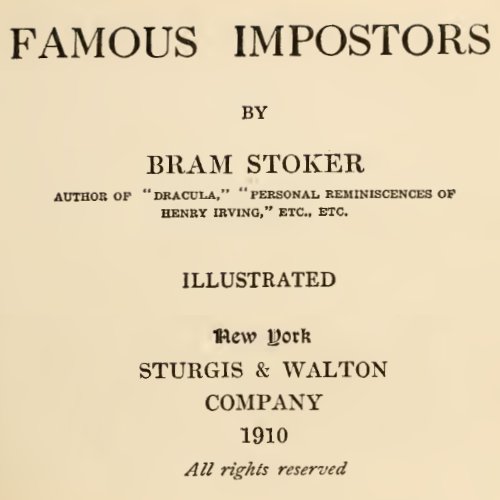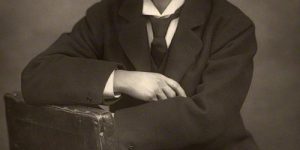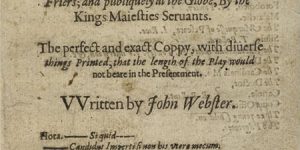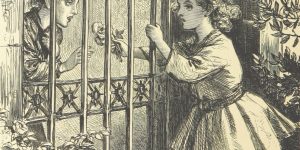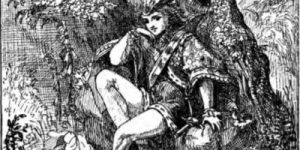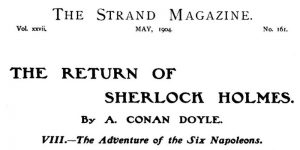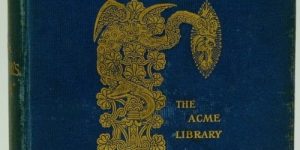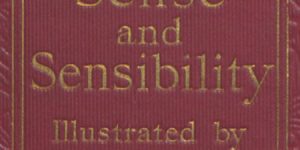The Wandering Jew : Famous Impostors by Bram Stoker
Famous Impostors : Legend The Wandering Jew
by
Bram Stoker
The Wandering Jew
The legend of the Wandering Jew has its roots in a belief in the possibility of human longevity beyond what is natural and normal. It is connected with the story of the Crucifixion and the mysteries that preceded and followed it. Our account may find its starting point in a book of extraordinary interest which made a sensation in the seventeenth century and is still delightful reading. The passage which should arrest our attention is as follows:
“The story of the Wandering Jew is very strange and will hardly obtain belief; yet there is a small account thereof set down by Matthew Paris from the report of an Armenian Bishop; who came into this Kingdom about four hundred years ago, and had often entertained this wanderer at his Table. That he was then alive, was first called Cartaphilus, was keeper of the Judgment Hall, whence thrusting out our Saviour with expostulation of his stay, was condemned to stay until His return; was after baptized by Ananias, and by the name of Joseph; was thirty years old in the dayes of our Saviour, remembered the Saints that arised with Him, the making of the Apostles’ Creed, and their several peregrinations. Surely were this true, he might be an happy arbitrator in many Christian controversies; but must impardonably condemn the obstinacy of the Jews, who can contemn the Rhetorick of such miracles, and blindly behold so living and lasting conversions.”
The above is taken from the work entitled “Pseudoxia Epidemica” or Enquiries into very many Received Tenets and Commonly Presumed Truths by Sir Thomas Brown, Knight M.D. This was first published in 1640, so that the “about four hundred years ago” mentioned would bring the report of the Armenian Bishop to the first half of the thirteenth century.
Thus unless there be something of an authoritative character to upset the theory, Matthew Paris must be taken as the first European narrator of the story. As a matter of fact the legend began just about the time thus arrived at. The great work in Latin, “Historia Major,” was begun by Roger of Wendover and completed in 1259 by the monk Matthew Paris. It was not however published—in our ordinary sense of the word—until the beginning of the year 1571 when Archbishop Parker took it in hand. In the meantime the art of printing had been established and the new world of thought and the reproduction of its fruit, had been developed for common use. The Historia Major was again printed in Zurich in 1589 and 1606. The next English edition was in 1640. This was reprinted in Paris in 1644. The English edition of forty years later, 1684, was a really fine specimen of typographic art. The authorship and date of its printing are given: Matthaei Paris, Monachi Albanensis Angli London MDCLXXXIV. The script is in ecclesiastical Latin and to any modern reader is of a fresh and almost child-like sincerity which at once disarms doubt or hostile criticism. Indeed it affords a good example of the mechanism of myth, showing how the littleness of human nature—vanity with its desire to shine and credulity in its primitive form, are not subject to the controlling influences of either sacredness of subject or the rulings of common sense. It lends another meaning to the quotation of Feste, the jester: Cucullus non facit Monachum. The artless narrative recorded in the Historia Major makes the whole inception of the myth transparent. In the monastery of St. Albans a conversation is held by the monks on one side and the Armenian Archbishop—name not given, on the other. The interpreter in French is one Henri Spigurnel a native of Antioch, servant of the bishop. We can gather even how Sir Thomas Brown M. D., doctor of Norwich and most open-minded of scientists, lent himself, unconsciously, to the propagation of error. Brown reading, or hearing read, the work of Matthew Paris took it for granted that the record was correct and complete; and in his own book summarises or generalises the statements made. For instance he says that the Armenian bishop had “often entertained this wanderer at his table” &c. Now it was his servant who told the monks that the wandering Jew whom he had seen and heard speaking many times dined at the table of his lord the Archbishop. This at once minimises the value of the statement, for it does away at once with the respect due to the bishop’s high office and presumed character, and with the sense of intellectual acumen and accuracy which might be expected to emanate from one of his scholarship and quality. Thus we get the story not from an accredited Bishop on a foreign mission—rare at the period and entrusted only to men of note—but from the gossip of an Armenian lacquey or valet, trying to show his own importance to a credulous serving brother of the monastery. And so, after all, coming from this source it is to be accepted with exceeding care—not to say doubt, even when seconded by the learned monastic scribe Matthew. So, also, for instance is his statement regarding the manner in which the wanderer’s life is miraculously prolonged. It is to this effect. Each hundredth year Joseph falls into a faint so that he lies for a time unconscious. When he recovers he finds that his age is restored to that which it was when the Lord suffered. Joseph, it must be borne in mind, is the Wandering Jew, once Cartaphilus, who had kept Pilate’s judgment-hall. Then Matthew himself takes up the story and gives what professes to be the ipsissima verba of the servant as to the conversation between Christ and Cartaphilus which culminated in the terrible doom pronounced on the janitor who, from the showing, did not seem a whit worse than any of the crowd present on that momentous day in Jerusalem. When Jesus, wearied already with carrying the great cross, leaned for a moment against the wall of the house of Cartaphilus just opposite the Judgment-hall the official said:
“‘Vade Jesu citius, vade, quid moraris?’ et Jesus severo vultu et oculo respiciens eum, dixit: ‘Ego vado. Expectabis donec veniam.'”
Now this is the whole and sole foundation of the individual Wandering Jew. I say “individual” because there were before long other variants, and many old beliefs and fables were appropriated and used to back up the marvellous story, invented by the Armenian servant and recorded by the learned monk, Matthew. Amongst these beliefs were those which taught that John the Baptist never died; that the aloe blooms only once in a hundred years; and that the phœnix renews itself in fire. It is the tendency of legendary beliefs to group or nucleate themselves as though there were a conscious and intentional effort at self-protection; and this, together with the natural human tendency to enlarge and elaborate an accepted idea, is responsible for much. The legend started in the thirteenth century, took root and flourished, and in the very beginning of the seventeenth a variant blossomed. In this Joseph, originally Cartaphilus, became Ahasuerus. In the long pause the story, after the manner of all things of earth, had grown, details not being lacking. The world was informed through the Bishop of Schleswig, how in 1547, at Hamburg, a man was seen in the Cathedral who arrested attention—why we are not told. He was about fifty years of age, of reverend manner, and dressed in ragged clothes; he bowed low at the name of Christ. Many of the nobility and gentry who saw him recognised him as one whom they had already seen in various places—England, France, Italy, Hungary, Persia, Spain, Poland, Moscow, Lieffland, Sweden, Denmark, Scotland, &c. Inquiry being made of him, he told the Bishop that he was Ahasuerus the shoe-maker of Jerusalem, who had been present at the Crucifixion and had ever since been always wandering. He was well posted in history, especially regarding the lives and sufferings of the Apostles, and told how, when he had directed Christ to move on, the latter had answered: “I will stand here and rest, but thou shalt move on till the last day.” He had been first seen, we are told, at Lubeck.
It is strange that in an age of religious domination many of the legends of Our Saviour seem to have been based on just such intolerant anger at personal slight as might have ruled a short-tempered, vain man. For instance look at one of the Christ legends which was reproduced in poor Ophelia’s distracted mind apropos of the owl, “They say, the owl was a baker’s daughter.” The Gloucestershire legend runs that Christ having asked for bread at baking time the mistress of the bakery took dough from the oven, but her daughter having remonstrated as to the size of the benefaction was turned into an owl. The penalty inflicted on the erring janitor of the Presidium is another instance.
The “Wandering Jew” legend once started, was hard to suppress. The thirteenth, fourteenth, fifteenth and sixteenth centuries were the ages of Jew-baiting in the kingdoms of the West, and naturally the stories took their colour from the prevailing idea.
In 1644, Westphalus learned from various sources that the Wandering Jew healed diseases, and that he had said he was at Rome when it was burned by Nero; that he had seen the return of Saladin after his Eastern Conquests; that he had been in Constantinople when Salimen had built the royal mosque; that he knew Tamerlane the Scythian, and Scander Beg, Prince of Epirus; that he had seen Bajazet carried in a cage by Tamerlane’s order; that he remembered the Caliphs of Babylon and of Egypt, the Empire of the Saracens, and the Crusades where he had known Godfrey de Bouillon. Amongst other things he seems to have apologised for not seeing the Sack of Jerusalem, because he was at that time in Rome at the Court of Vespasian.
The Ahasuerus version of the Wandering Jew legend seems to have been the popular one amongst the commonalty in England. As an instance might be quoted the broad-sheet ballad of 1670. It is not without even historical significance as it marks the measure of the time in many ways. It is headed: “The Wandering Jew, or the Shoemaker of Jerusalem who lived when Our Lord and Saviour Jesus Christ was crucified appointed by Him to live until Coming again. Tune, The Lady’s Fall &c. Licens’d and Enter’d according to order.” The imprint runs: “Printed by and for W. O. and sold by the Booksellers of Pyecorner and London-Bridge.”
A century and a half later—1828—was published a much more pretentious work on the same theme. This was a novel written by Rev. George Croly. It was called: “Salathiel: a Story of the Past, the Present, the Future.” It was published anonymously and had an immediate and lasting success. It was founded on historical lines, the author manifestly benefiting by the hints afforded by the work of that consummate liar (in a historical sense) Westphalus—or his informant. Croly was a strange man with a somewhat abnormal faculty of abstraction. I used to hear of him from my father who was a friend of his about a hundred years ago. Being of gentle nature he did not wish to cause any pain or concern to his family or dependents; but at the same time he, as a writer, had to guard himself against interruption and consequent digression of his thoughts during the times he set apart for imaginative work. So he devised a scheme which might often be put in practice with advantage by others similarly employed. When settling down to a spell of such work—which as every creative writer knows involves periods of mental abstraction though of bodily restlessness—he would stick an adhesive wafer on his forehead. The rule of the house was that when he might be adorned in this wise no one was to speak to him, or even notice him, except under special necessity.
The great vogue of Salathiel lasted some ten or more years, when the torch of the Wandering Jew was lighted by Eugene Sue the French novelist who had just completed in the Débats his story “Les Mystères de Paris.” As its successor he chose the theme adopted by Croly, and the new novel Le Juif-Errant ran with overwhelming success in the Constitutionnel.
Sue was what in modern slang is called “up to date.” He knew every trick and dodge of the world of advertisement, and in conjunction with his editor, Dr. Veron, he used them all. But he had good wares to exploit. His novels are really excellent, though the changes in social life and in religious, political and artistic matters, which took place between 1844 and 1910, make some things in them seem out of date. His great imagination, and his firm and rapid grasp of salient facts susceptible of being advantageously used in narrative, pointed out to him a fresh road. It was not sufficient to the hour and place that Cartaphilus—or Joseph—or Ahasuerus, or Salathiel or whatever he might be called—should purge his sin by his personal sufferings alone. In the legend, up to then accepted, he had long ago repented; so to increase the poignancy of his sufferings, Sue took from the experience of his own time a means of embittering the very inmost soul of such an one. He must be made to feel that his existence is a curse not only to himself but to all the world. To this end he attached to the Wanderer the obligation of carrying a fell disease. The quick brain of the great feuilletonist seized the dramatic moment for utilising the occasion. A dozen years before, the frightful spread of the cholera, which had once again wrought havoc, woke the whole world to new terror. Some one of uneasy mind who found diversion in obscure comparisons, noted from the records of the disease that its moving showed the same progress in a given direction as a man’s walking. A hint was sufficient for the public who eagerly seized the idea that the Wandering Jew had, from the first recorded appearance of the cholera, been the fated carrier of that dreaded pestilence. The idea seemed to be a dramatic inspiration and had prehensile grasp. Great as had been the success of the Mysteries of Paris, that of The Wandering Jew surpassed it, and for half a century the new novel kept vividly before its readers the old tradition, and so brought it down to the present.
We may now begin to ask ourselves who and where in this great deception was the impostor. Who was the guilty one? And at first glance we are inclined to say “There is none! Whatever the error, mistake, deception, or false conclusion, there has been no direct guilt.” This is to presuppose that guilt is of conscious premeditation; and neither intention of evil nor consciousness of guilt is apparent. In legal phrase the mens rea is lacking.
It is a purely metaphysical speculation whether guilt is a necessary element of imposition. One is an intellectual experience, the other is an ethical problem; and if we are content to deal with responsibility for another’s misdoing, the question of the degree of blameworthiness is sufficient. Let us try a process of exclusions. The complete list of those who had a part in the misunderstanding regarding the myth of the Wandering Jew, leaving out the ostensible fictionists, were:
The Abbot of St. Albans, the Archbishop of Armenia, the interpreter, the Archbishop’s servant, the monks or laybrothers who singly or in general conversed with any of the above; and finally Matthew Paris who recorded the story in its various phases. Of these we must except from all blame both the Abbot of St. Albans and the Archbishop of Armenia, both of whom were good grave men of high character and to each of whom had been entrusted matters of the highest concern. The interpreter seems to have only fulfilled his office with exactitude; if in any way or part he used his opportunity to impose on the ignorance of the host or the guest there is no record, no suggestion of it. Matthew Paris was a man of such keenness of mind, of such observation and of such critical insight, that even to-day, after a lapse of over five hundred years, and the withstanding of all the tests of a new intellectual world which included such inventions as printing and photography, he is looked upon as one of the ablest of chroniclers. Moreover he put no new matter nor comments of his own into the wonderful and startling narratives which he was called on to record. He even hints at or infers his own doubt as to the statements made. The monks, servants and others mentioned generally, were merely credulous, simple people of the time, with reverence for any story regarding the Via Dolorosa, and respect or awe for those in high places.
There remains but the servant of the foreign Archbishop. It is to him that we must look for any outrage on our normal beliefs. He was manifestly a person of individually small importance—even Matthew Paris whose trained work it was to record with exactness, and whose duty it therefore was to sustain or buttress main facts, did not think it necessary or worth while to mention his name. He had in himself none of the dignity, honour, weight, learning or position of the noble of the Church who was the Abbot’s guest. He was after all but a personal servant; probably one of readiness and expediency with a quick imagination and a glib tongue. One who could wriggle through a difficult position, defend himself with ready acquiescence, gain his ends of securing his master’s ease, and find all necessary doors open through the bonhommie of his fellow servitors. Such an one accustomed to the exigencies of foreign travel, must have picked up many quaint conceits, legends and japes, and was doubtless a persona grata liked and looked up to by persons of his own class, sanctified to some little extent by the reflected glory of his master’s great position. It is more than likely that he had been the recipient of many confidences regarding legend and conjecture concerning sacred matters, and that any such legend as he spoke of would have been imparted under conditions favourable to his own comfort. After the manner of his kind his stories doubtless lost nothing in the telling and gained considerably in the re-telling. Even in the short record of Matthew Paris, there is evidence of this in the way in which, after the striking story of Cartaphilus has been told, he returns to the matter again, adding picturesque and inconclusive details of the manner of the centennial renewal of the wanderer’s youth. The simplest analysis here will show the falsity of the story; what the great logician Archbishop Whately always insisted on—”internal evidence”—is dead against the Armenian valet, courier, or servitor. He gave circumstantial account of the periodic illness, loss of memory, and recovery of youth on the part of Cartaphilus; but there is no hint of how he came to know it, and Cartaphilus could not have told him, nor anybody else. We may, I think, take it for granted that no other mere mortal was present, for, had any other human being been there, all the quacksalvers of a thousand miles around would have moved heaven and earth to get information of what was going on, since in mediæval days there was nearly as much competition in the world of charlatanism as there is to-day in the world of sport. The Armenian was much too handy a man at such a crisis to be found out, so we may give him the benefit of the doubt and at once credit him with invention. It is hard to understand—or even to believe without understanding—that so mighty a legend and one so tenacious of life, arose and grew from such a beginning. And yet it is in accord with the irony of nature that one who has unintentionally and unwittingly achieved a publicity which would dwarf the malign reputation of Herostratus should have his name unrecorded.
Famous Impostors
Chapter I. Pretenders
A. Perkin Warbeck
B. The Hidden King
C. Stephan Mali
D. The False Dauphins
E. Princess Olive
Chapter II. Practitioners of Magic
A. Paracelsus
B. Cagliostro
C. Mesmer
Chapter III.
The Wandering Jew
Chapter IV.
John Law
Chapter V. Witchcraft and Clairvoyance
A. Witches
B. Doctor Dee
C. La Voisin
D. Sir Edward Kelley
E. Mother Damnable
F. Matthew Hopkins
Chapter VI.
Arthur Orton (Tichborne claimant)
Chapter VII. Women as Men
A. The Motive for Disguise
B. Hannah Snell
C. La Maupin
D. Mary East
Chapter VIII. Hoaxes, etc.
A. Two London Hoaxes
B. The Cat Hoax
C. The Military Review
D. The Toll-Gate
E. The Marriage Hoax
F. Buried Treasure
G. Dean Swift’s Hoax
H. Hoaxed Burglars
I. Bogus Sausages
J. The Moon Hoax
Chapter IX.
Chevalier d’Eon
Chapter X.
The Bisley Boy

